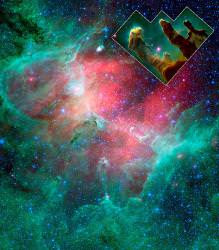 One of the most famous space photographs ever taken is the “Pillars of Creation” by Hubble, an amazing image of the Eagle nebula. But a new image from the Spitzer Space Telescope provides evidence that those towers of gas and dust might have already been wiped away.
One of the most famous space photographs ever taken is the “Pillars of Creation” by Hubble, an amazing image of the Eagle nebula. But a new image from the Spitzer Space Telescope provides evidence that those towers of gas and dust might have already been wiped away.
Continue reading “Eagle Nebula’s Pillars Were Wiped Out Thousands of Years Ago”
Open Star Clusters Die Young
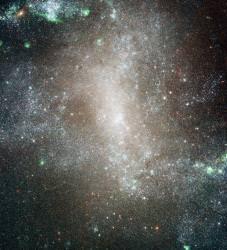 Massive globular clusters are some of the oldest objects in the Universe, held together by the collective gravity of their stars. Open star clusters, on the other hand, don’t live so long.
Massive globular clusters are some of the oldest objects in the Universe, held together by the collective gravity of their stars. Open star clusters, on the other hand, don’t live so long.
Continue reading “Open Star Clusters Die Young”
A New View of Kepler’s Supernova Remnant
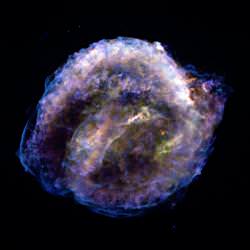 NASA’s Chandra X-Ray Observatory has created this amazing image of one of the youngest supernova remnants in the galaxy. The supernova that created it blazed in the sky more than 400 years ago, before the telescope had even been invented. No problem, though, it was bright enough that you didn’t need a telescope – it reached the brightness of Jupiter at its peak. And one of the greatest astronomers in history, Johannes Kepler was there to see it.
NASA’s Chandra X-Ray Observatory has created this amazing image of one of the youngest supernova remnants in the galaxy. The supernova that created it blazed in the sky more than 400 years ago, before the telescope had even been invented. No problem, though, it was bright enough that you didn’t need a telescope – it reached the brightness of Jupiter at its peak. And one of the greatest astronomers in history, Johannes Kepler was there to see it.
Continue reading “A New View of Kepler’s Supernova Remnant”
Blizzard of Snowflake Particles Around a Young Star
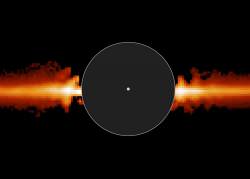 The Hubble Space Telescope has imaged a ring of dust around a nearby star that will probably become a system of planets. The star is AU Microscopii, and it’s located about 32 light-years away in the southern constellation of Microscopium (the Microscope). The particles are probably as fluffy as snowflakes, and about 10 times larger than typical interstellar dust grains.
The Hubble Space Telescope has imaged a ring of dust around a nearby star that will probably become a system of planets. The star is AU Microscopii, and it’s located about 32 light-years away in the southern constellation of Microscopium (the Microscope). The particles are probably as fluffy as snowflakes, and about 10 times larger than typical interstellar dust grains.
Continue reading “Blizzard of Snowflake Particles Around a Young Star”
Hubble Helps Make a 3-D Map of Dark Matter
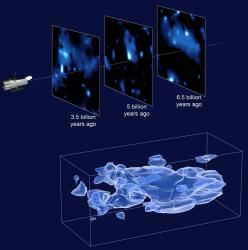 A team of astronomers has created a three-dimensional map of dark matter distribution across the Universe. This map gives some of the best evidence that normal matter, like you and me, stars and planets, accumulate around the densest regions of dark matter.
A team of astronomers has created a three-dimensional map of dark matter distribution across the Universe. This map gives some of the best evidence that normal matter, like you and me, stars and planets, accumulate around the densest regions of dark matter.
Continue reading “Hubble Helps Make a 3-D Map of Dark Matter”
First Triple Quasar Discovered
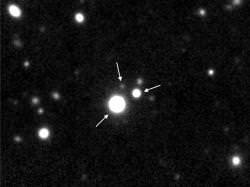 Quasars are some of the brightest objects in the Universe, beaming radiation across billions of light-years of space. Although they were a mystery for many years, astronomers now believe they’re the bright radiation from matter clogging up around an actively feeding supermassive black hole.
Quasars are some of the brightest objects in the Universe, beaming radiation across billions of light-years of space. Although they were a mystery for many years, astronomers now believe they’re the bright radiation from matter clogging up around an actively feeding supermassive black hole.
Continue reading “First Triple Quasar Discovered”
Gas Giants Turn Up Early After Star Formation
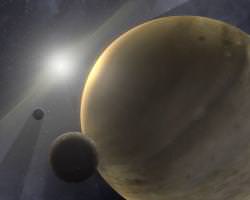 New research indicates that gas giants, like Jupiter and Saturn, form quickly after their stars do. In fact, they probably form within the first 10 million years of a star’s life, or else they never form at all.
New research indicates that gas giants, like Jupiter and Saturn, form quickly after their stars do. In fact, they probably form within the first 10 million years of a star’s life, or else they never form at all.
Continue reading “Gas Giants Turn Up Early After Star Formation”
White Dwarf Recently Consumed an Asteroid
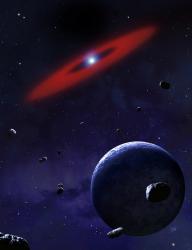 Astronomers have discovered a ring of metal-rich gas surrounding a relatively nearby white dwarf star that gives us a glimpse at the future of our own Solar System.
Astronomers have discovered a ring of metal-rich gas surrounding a relatively nearby white dwarf star that gives us a glimpse at the future of our own Solar System.
Continue reading “White Dwarf Recently Consumed an Asteroid”
Use Galactic Gravitational Lenses to Really See the Universe
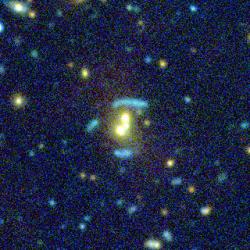 To see any distance in space, you need some kind of telescope. We’ve got some pretty powerful ones here on Earth, but nature has us beat with gravitational lenses. This is a phenomenon when a relatively nearby object passes directly between us and a more distant object. The gravity from the nearby object acts as like a telescope lens to bend light and magnify the more distant object.
To see any distance in space, you need some kind of telescope. We’ve got some pretty powerful ones here on Earth, but nature has us beat with gravitational lenses. This is a phenomenon when a relatively nearby object passes directly between us and a more distant object. The gravity from the nearby object acts as like a telescope lens to bend light and magnify the more distant object.
Continue reading “Use Galactic Gravitational Lenses to Really See the Universe”
Insanely High Resolution Photo of the Tarantula Nebula
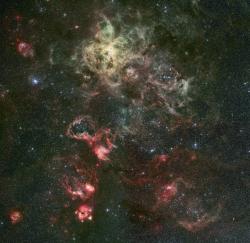 I’m not sure why, but the European Southern Observatory has decided to give their web servers and bandwidth a real workout with their latest photo release. But I’m glad they did.
I’m not sure why, but the European Southern Observatory has decided to give their web servers and bandwidth a real workout with their latest photo release. But I’m glad they did.
Continue reading “Insanely High Resolution Photo of the Tarantula Nebula”
